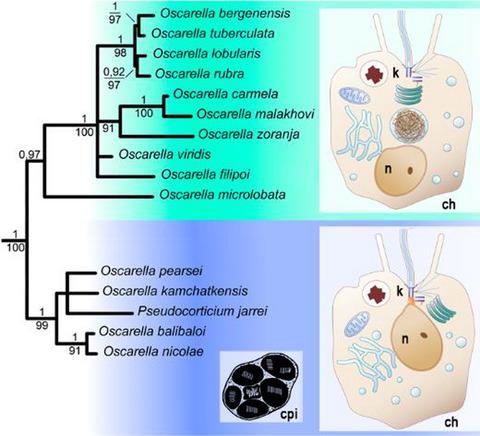当前位置:
X-MOL 学术
›
J. Zool. Syst. Evol. Res.
›
论文详情
Our official English website, www.x-mol.net, welcomes your
feedback! (Note: you will need to create a separate account there.)
Morphological variability of choanocyte kinetids supports a novel systematic division within Oscarellidae (Porifera, Homoscleromorpha)
Journal of Zoological Systematics and Evolutionary Research ( IF 2.0 ) Pub Date : 2020-09-20 , DOI: 10.1111/jzs.12417 Pozdnyakov Igor 1 , Sokolova Agniya 2 , Karpov Sergey 1, 3 , Ruiz César 4 , Pérez Thierry 4 , Ekimova Irina 5 , Ereskovsky Alexander 2, 4, 6
Journal of Zoological Systematics and Evolutionary Research ( IF 2.0 ) Pub Date : 2020-09-20 , DOI: 10.1111/jzs.12417 Pozdnyakov Igor 1 , Sokolova Agniya 2 , Karpov Sergey 1, 3 , Ruiz César 4 , Pérez Thierry 4 , Ekimova Irina 5 , Ereskovsky Alexander 2, 4, 6
Affiliation

|
Homoscleromorpha is a recently recognized class within the phylum Porifera. While molecular analyses support monophyly of Homoscleromorpha, morphological data are largely lacking. Here, we investigate and comparatively analyze the detailed morphology of kinetids (flagellar apparatus) in choanocytes of ten Oscarella species. The kinetid is known to be a phylogenetically important trait that can possibly reflect relationships of sponges at the level of orders. We also conduct a phylogenetic analysis based on previously published sequences. We found the family Oscarellidae is subdivided into two large groups, and choanocyte kinetids structure strongly supports this division. The first group includes Oscarella lobularis, O. tuberculata, O. bergenensis, O. viridis, O. rubra, O. malakhovi, O. microlobata, O. carmela, O. filipoi, and O. zoranja. These species possess nuclei located in a basal position without any connection to the kinetosome. The second group includes O. balibaloi, O. nicolae, O. kamchatkensis, O. pearsei, O. imperialis, and Pseudocorticium jarrei, whose nuclei are connected with the kinetosome. In addition, this second group also shares mesohylar spherulous cells harboring paracrystalline inclusions. The choanocyte kinetid structure seems to be an essential phylogenetic and diagnostic morphological trait, and we propose to include it in future species descriptions. Our results imply assignation of the second group to the genus Pseudocorticium. This taxonomic suggestion, however, needs additional data on the remaining Oscarella species.
中文翻译:

软骨细胞节肢动物的形态变异性支持O虫科(Porifera,Homoscleromorpha)内的一种新的系统分裂
同型是最近被认可的门类。尽管分子分析支持同形异形体,但仍缺乏形态学数据。在这里,我们调查并比较分析了十个Oscarella菌种的鞭毛细胞中的剑突(鞭毛器)的详细形态。已知类人动物是系统发育上重要的性状,可以在阶次水平上反映海绵的关系。我们还根据以前发布的序列进行系统发育分析。我们发现,Oscarellidae家族被分为两大类,而软骨细胞的肌动蛋白结构强烈支持这一分裂。第一组包括小叶 Oscarella lobularis,O。 结核菌,O。 bergenensis,Ö。 贻贝,Ö。 鲁拉,O。 malakhovi,Ö。 microlobata,Ö。 卡梅拉,O。 filipoi,并Ò。 zoranja。这些物种的核位于基本位置,与动子体没有任何联系。第二组包括Ò。 balibaloi,Ö。 尼古拉,Ö。 堪察加州。 pearsei,O-。 Imperialis和Jarsei假核皮层,其核与动子体相连。另外,这第二组还共享具有顺晶包裹体的中膜球状细胞。choanocyte kinetid结构似乎是必不可少的系统发育和诊断形态特征,我们建议将其包括在将来的物种描述中。我们的结果暗示第二组属于伪皮质属。但是,这种分类学建议需要有关其余Oscarella菌种的其他数据。
更新日期:2020-09-20
中文翻译:

软骨细胞节肢动物的形态变异性支持O虫科(Porifera,Homoscleromorpha)内的一种新的系统分裂
同型是最近被认可的门类。尽管分子分析支持同形异形体,但仍缺乏形态学数据。在这里,我们调查并比较分析了十个Oscarella菌种的鞭毛细胞中的剑突(鞭毛器)的详细形态。已知类人动物是系统发育上重要的性状,可以在阶次水平上反映海绵的关系。我们还根据以前发布的序列进行系统发育分析。我们发现,Oscarellidae家族被分为两大类,而软骨细胞的肌动蛋白结构强烈支持这一分裂。第一组包括小叶 Oscarella lobularis,O。 结核菌,O。 bergenensis,Ö。 贻贝,Ö。 鲁拉,O。 malakhovi,Ö。 microlobata,Ö。 卡梅拉,O。 filipoi,并Ò。 zoranja。这些物种的核位于基本位置,与动子体没有任何联系。第二组包括Ò。 balibaloi,Ö。 尼古拉,Ö。 堪察加州。 pearsei,O-。 Imperialis和Jarsei假核皮层,其核与动子体相连。另外,这第二组还共享具有顺晶包裹体的中膜球状细胞。choanocyte kinetid结构似乎是必不可少的系统发育和诊断形态特征,我们建议将其包括在将来的物种描述中。我们的结果暗示第二组属于伪皮质属。但是,这种分类学建议需要有关其余Oscarella菌种的其他数据。


















































 京公网安备 11010802027423号
京公网安备 11010802027423号